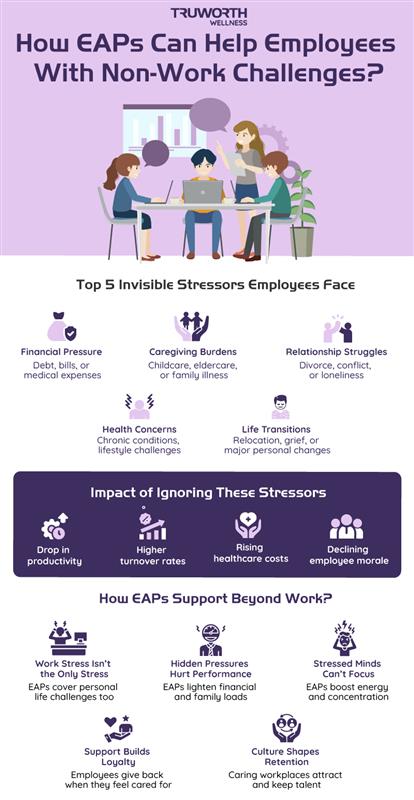Invisible Stressors: How EAPs Can Help Employees With Non-Work Challenges?

When we think of workplace stress, we often imagine looming deadlines, endless meetings, or difficult projects. But many employees struggle with invisible stressors that have nothing to do with their job description. From financial worries and caregiving responsibilities to personal relationship conflicts and health issues, these non-work challenges quietly impact employee performance, morale, and overall well-being.
While organizations may invest heavily in training, productivity tools, or flexible schedules, the root cause of an employee’s struggle often lies outside office walls. This is where Employee Assistance Programs (EAPs) can make a real difference.

The Weight of Invisible Stressors
Employees don’t leave their personal lives at the office door. Some of the most common but overlooked stressors include:
- Financial pressures – mounting debts, medical expenses, or sudden emergencies.
- Caregiving responsibilities – balancing work with taking care of children, elderly parents, or sick family members.
- Relationship struggles – divorce, conflict at home, or emotional isolation.
- Health-related issues – chronic illnesses or lifestyle-related conditions that drain physical and mental energy.
- Life transitions – relocation, marriage, parenthood, or grief from loss.
These stressors may not be visible to managers or HR, but they directly affect focus, engagement, and long-term career growth. Left unaddressed, they often manifest as absenteeism, burnout, or quiet quitting.
Why Organizations Can’t Ignore Non-Work Challenges?
Many companies still operate under the assumption that personal problems are private and shouldn’t spill over into the workplace. But in reality, unresolved non-work challenges have measurable impacts:
- Productivity dips: Stressed employees may struggle to concentrate, meet deadlines, or maintain accuracy.
- Increased turnover: Workers dealing with prolonged stress often seek new jobs in hopes of a fresh start.
- Higher healthcare costs: Chronic stress contributes to physical illness, mental health struggles, and absenteeism.
- Culture erosion: A stressed workforce struggles to collaborate, innovate, and stay motivated.
Forward-thinking organizations recognize that supporting employees holistically is not just compassionate—it’s also a smart business strategy.
How EAPs Bridge the Gap?
An Employee Assistance Program (EAP) provides confidential, professional support to help employees navigate non-work challenges that weigh on their well-being. Here’s how EAPs make an impact:
- Counseling Services – Employees can access trained counselors for emotional support, stress management, or relationship advice.
- Financial Guidance – From debt management to financial planning, EAPs help reduce money-related anxiety.
- Legal Assistance – Employees can consult experts on legal matters like family disputes, contracts, or housing issues.
- Work-Life Resources – Support in finding childcare, eldercare, or healthcare services to ease caregiving burdens.
- Wellness Coaching – Guidance on nutrition, sleep, and healthy lifestyle habits that build resilience.
The confidential nature of EAPs ensures employees feel safe seeking help without fear of workplace stigma.
Making EAPs More Accessible and Effective
For EAPs to truly support employees with invisible stressors, organizations should:
- Raise Awareness: Many employees don’t even know their company offers EAP services. Regular communication is essential.
- Normalize Help-Seeking: Leaders should openly advocate for mental health and personal well-being to reduce stigma.
- Offer 24/7 Access: Life challenges don’t stick to office hours; support should be available anytime, anywhere.
- Integrate with Wellness Programs: Linking EAPs with existing health and well-being initiatives increases usage and impact.
- Track Impact Beyond Usage Rates: Look at improvements in retention, engagement, and employee satisfaction.
The Bigger Picture: Humanizing Workplaces
Invisible stressors remind us that employees are human first, professionals second. By supporting them through an EAP, organizations send a powerful message: We care about you beyond your role. This builds loyalty, trust, and a healthier work culture.
When employees feel supported both at work and in life, they bring their best selves to the workplace—boosting not just productivity, but also creativity, collaboration, and long-term growth.
Invisible stressors may be hard to spot, but their impact is impossible to ignore. EAPs are not just a wellness benefit—they are a lifeline that helps employees cope with life’s challenges while thriving at work.
If your organization wants to go beyond surface-level wellness and provide holistic care, Truworth Wellness can help. With our comprehensive EAP services and digital wellness tools, you can empower your employees to tackle personal and professional challenges with confidence.
Start building a workplace where invisible stressors don’t go unnoticed. Explore Truworth Wellness EAP solutions today.